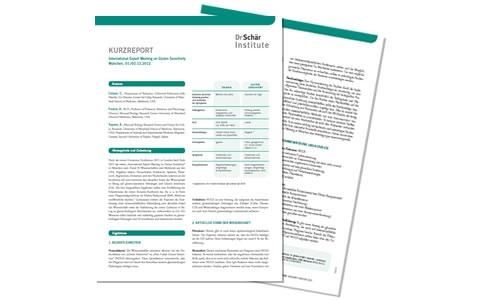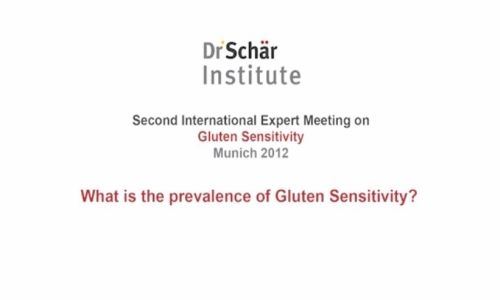Prevalencia incierta de la sensibilidad al gluten/trigo

Hasta la fecha solo existen estimaciones sobre la frecuencia de la sensibilidad al gluten/ trigo. Esta se encuentra entre el 1 y el 6 % de la población, lo que demuestra que esta nueva entidad tiene una prevalencia notablemente superior a la de la enfermedad celíaca. La cifra en comparación con el diagnóstico real es probablemente demasiado alta, como ocurre en el caso de la enfermedad celíaca.
La sensibilidad al gluten/trigo (SG/T) probablemente se da más a menudo que la enfermedad celíaca y la alergia al trigo, no obstante, hasta la fecha todavía faltan estudios epidemiológicos completos para verificar estas estimaciones. Las estimaciones actuales se basan, entre otros aspectos, en los resultados de un estudio realizado en un centro de investigación sobre enfermedad celíaca de EE. UU. (Center for Celiac Research, University of Maryland). Según el estudio, en el periodo comprendido entre 2004 y 2010 un 6 % de los casi 9000 pacientes tratados en dicho centro cumplían los criterios para la SG/T y se quejaban de síntomas relacionados con la entidad, sin que fueran celíacos o alérgicos al trigo.
Conclusión de la conferencia de consenso Consensus Conference sobre los trastornos relacionados con el gluten
Más información sobre este tema...
Download
1
Mostrar todo
Estudios
1
Mostrar todo
Vídeos
1
Mostrar todo

Resumen Expert Meeting GS 2012

Systematic review: non coeliac gluten sensitivity
Background
Non coeliac gluten sensitivity (NCGS) is a controversial emerging disorder. Despite reported symptoms related to the ingestion of gluten, NCGS remains a diagnosis based on the exclusion of coeliac disease, given the absence of reliable biomarkers.
Aim
To evaluate the prevalence, diagnostic exclusion of coeliac disease and the efficacy of a gluten-free diet (GFD) for NCGS patients.
Methods
A PubMed search was performed up to December 2014. According to consensus diagnostic criteria, NCGS was defined as self-reported gluten intolerance, negative coeliac serology and absence of villous atrophy. Studies evaluating the impact of a GFD on patients with irritable bowel syndrome (IBS) were also included.
Results
Prevalence rates of NCGS (0.5–13%) differed widely. Seventeen studies, including 1561 patients (26 children), met the inclusion criteria for NCGS. HLA haplotypes could not be linked to histology [normal or lymphocytic enteritis (LE)] in 1123 NCGS patients. HLADQ2/DQ8 haplotypes were present in 44% of NCGS patients. After advanced diagnostic techniques in 189 NCGS patients combining LE and HLADQ2/DQ8 haplotypes, 39 (20%) were reclassified as coeliac disease. There was a higher than expected family history of coeliac disease and autoimmune disorders in NCGS patients. A GFD resulted in variable results for variable, but significantly improved stool frequency in HLADQ2 positive diarrhoea-predominant IBS patients.
Conclusions
Prevalence rates for NCGS are extremely variable. A subset of NCGS patients might belong in the so-called ‘coeliac-lite’ disease. The benefit of a GFD for NCGS patients is currently controversial. HLADQ2 positive diarrhoea- type IBS patients might gain symptom improvement from a GFD.
Resource: Aliment Pharmacol Ther. 2015 May;41(9):807-20. doi: 10.1111/apt.13155. Epub 2015 Mar 6.
Molina-Infante J, Santolaria S, Sanders DS, Fernández-Bañares F.
Non coeliac gluten sensitivity (NCGS) is a controversial emerging disorder. Despite reported symptoms related to the ingestion of gluten, NCGS remains a diagnosis based on the exclusion of coeliac disease, given the absence of reliable biomarkers.
Aim
To evaluate the prevalence, diagnostic exclusion of coeliac disease and the efficacy of a gluten-free diet (GFD) for NCGS patients.
Methods
A PubMed search was performed up to December 2014. According to consensus diagnostic criteria, NCGS was defined as self-reported gluten intolerance, negative coeliac serology and absence of villous atrophy. Studies evaluating the impact of a GFD on patients with irritable bowel syndrome (IBS) were also included.
Results
Prevalence rates of NCGS (0.5–13%) differed widely. Seventeen studies, including 1561 patients (26 children), met the inclusion criteria for NCGS. HLA haplotypes could not be linked to histology [normal or lymphocytic enteritis (LE)] in 1123 NCGS patients. HLADQ2/DQ8 haplotypes were present in 44% of NCGS patients. After advanced diagnostic techniques in 189 NCGS patients combining LE and HLADQ2/DQ8 haplotypes, 39 (20%) were reclassified as coeliac disease. There was a higher than expected family history of coeliac disease and autoimmune disorders in NCGS patients. A GFD resulted in variable results for variable, but significantly improved stool frequency in HLADQ2 positive diarrhoea-predominant IBS patients.
Conclusions
Prevalence rates for NCGS are extremely variable. A subset of NCGS patients might belong in the so-called ‘coeliac-lite’ disease. The benefit of a GFD for NCGS patients is currently controversial. HLADQ2 positive diarrhoea- type IBS patients might gain symptom improvement from a GFD.
Resource: Aliment Pharmacol Ther. 2015 May;41(9):807-20. doi: 10.1111/apt.13155. Epub 2015 Mar 6.
Molina-Infante J, Santolaria S, Sanders DS, Fernández-Bañares F.

Systematic review: non coeliac gluten sensitivity
Background
Non coeliac gluten sensitivity (NCGS) is a controversial e...
What is the prevalence of Gluten Sensitivity?
International Expert Meeting on Gluten Sensitivity 2012 in Munich, Germany

What is the prevalence of Gluten Sensitivity?
International Expert Meeting on Gluten Sensitivity 2012 in Munich, Ger...
www.drschaer-institute.com
